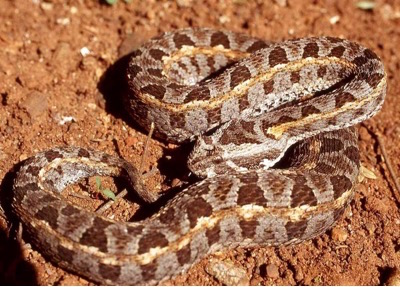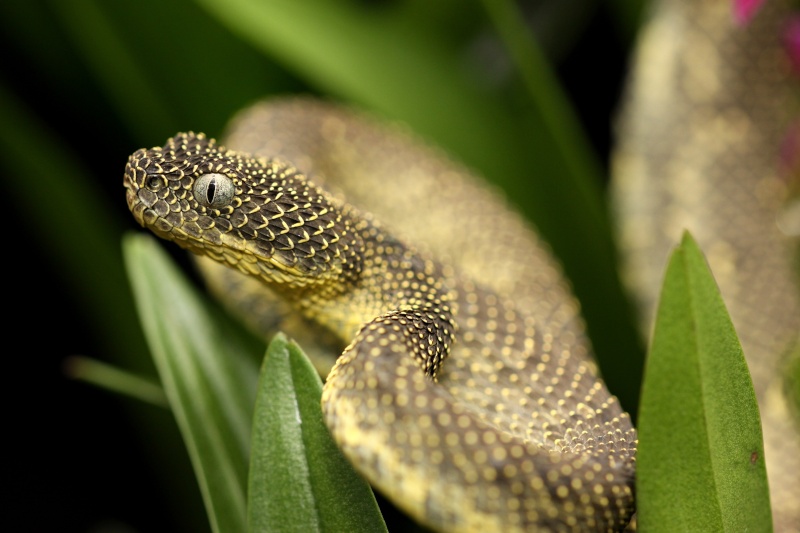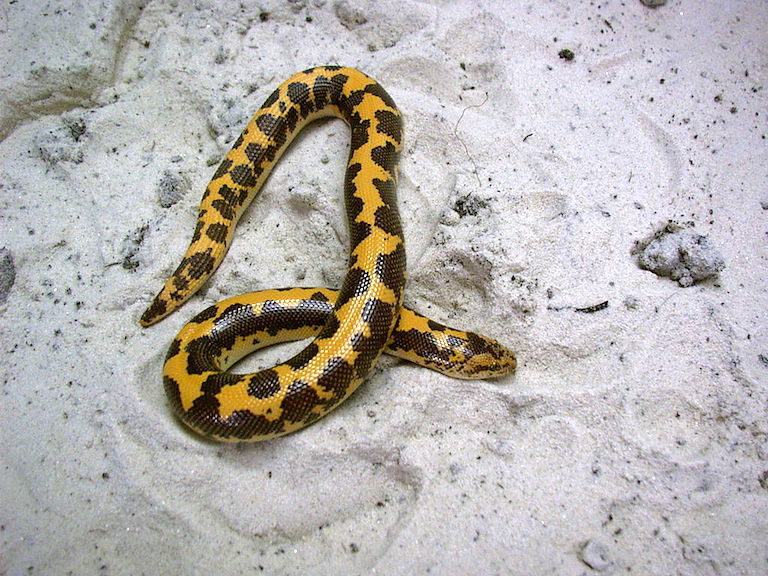- Early this year Kenyan authorities placed tight new restrictions on the trade and export of several snake species, including the Kenya horned viper (Bitis worthingtoni) and the Mt. Kenya Bush Viper (Atheris desaixi).
- The two snake species are regularly trafficked abroad for the pet trade as well as for luxury food and medical reseach.
- Authorities say criminal networks regularly bribe officials and are investigating whether politicians may be involved in the trade.
- Nevertheless, the Kenyan government appears to be taking a hard line against viper traffic, cracking down on smugglers and ramping up international cooperation to fight viper traffic.
Early this year Kenyan authorities tightened restrictions on the trade and export of several snake species, including two of the world’s deadliest vipers. The decision follows a resolution to list the two species under the Convention on International Trade in Endangered Species of Wild Fauna and Flora (CITES) at a meeting in South Africa last September and October.
The species in question are the Kenya horned viper (Bitis worthingtoni) and the Mt. Kenya bush viper or Ashe’s viper (Atheris desaixi). The snakes have been finding their way to zoos and pet shops in Europe, the United States, Mexico, and China. The venom is also extracted for research on chronic diseases and drug development and to manufacture certain medicines.
Kenyan police records show that the entertainment industry is also part of the problem. Circuses both domestically and abroad buy the vipers for stunt acts — a dangerous proposition as the venom kills within eight minutes of entering the bloodstream after a snakebite.
Both species prefer cool weather and can only be found in the vicinity of Mt. Kenya, Africa’s second highest mountain, at altitudes above 1,200 meters where temperatures can seasonally dip below 32 degrees Fahrenheit.
No recent census has been conducted to determine the numbers of either species in the wild but they are estimated to be in the thousands. Both species are thought to be in decline due to habitat destruction from logging and agricultural conversion, as well as the trade in live snakes. They have disappeared from many locales where they once were common.

Viper trade restriction
According to Phillip Kisima, an officer with the national Kenya Police Service who has been investigating viper traffickers for many years, between 100 and 350 snakes have been smuggled out of the country each year since the early 1980s. A Kenyan snake catcher can sell each viper for around $100 to $150, but abroad the price can rise twelve-fold or more, according to Kisima.
“The increasing level of corruption among many African countries continues to be an obstacle. So, [principles] and working together with those countries will be vital,” Kisima told Mongabay.
At the CITES meeting, Kenya proposed to list both species under Appendix II of the convention, which includes species not currently threatened with extinction but that may become so if their trade is not regulated. The proposals were approved by all 182 participating member nations, according to Solomon Kyalo, head of Kenya’s CITES program.
Kyalo told Mongabay that Kenya is now working with the other CITES members to monitor illegal trade across international borders.
International trade in Appendix II species can only occur with an export permit from the relevant country’s authorities, and the separate restrictions on export of the two vipers that Kenya enacted soon after the CITES listing makes international trade in the two species illegal, except under certain limited circumstances, such as for medical research.
Kyalo added that even the trade in viper eggs and body parts is now regulated and requires a government-issued permit to take place.
“This means that if one has to trade the vipers, you need a permit” from the Kenya Wildlife Service (KWS) said Kyalo. “So far, no one has ever applied for a permit to farm them or even export them.”
He added that both vipers should eventually be included in Appendix I, which is reserved for species threatened with extinction and permits trade only for non-commercial purposes, such as research.

Bribery and murder
However, Kisima the police officer doesn’t have much faith that the new restrictions on international trade will have much effect. “In a country riddled with corruption, the traffickers will find other means of trafficking the snakes. Only time will tell how successful the new regulations will be,” he said.
Snake traders frequently bribe law enforcement officers, Kisima said. “They even threaten us with death. So sometimes our work becomes complicated especially when we refuse any cash proposals from them.”
Kisima pointed to an incident last year in Nairobi, when viper smugglers killed two policemen. He said the case is still under investigation and the main suspect appears to be in hiding.
“Bribing intelligence networks across borders is not a difficult task for the crooks as they are well connected and have international networks,” Kisima said.
“They smuggle the young ones as they are not easily detected by machines at airports. They are then bred abroad for the pet trade,” he said.
He added that the Kenya Police Service is investigating whether senior government officials are implicated in the viper trade as a means to fund their political campaigns.
Andrew Musunda, a 50-year-old former viper smuggler, was released from prison last year. He told Mongabay that smuggling networks operate out of the prisons.
“Some crimes are even committed by fellow prisoners while they are imprisoned. They work maliciously with some rogue law enforcers, including prison warders, whom they pay a small fee to make calls and do business transactions,” Musunda said.
Today he volunteers with the police to track captured snakes and identify smugglers, and said he does not plan to go back to viper smuggling. “They have promised me permanent employment with time. I served 11 years in prison. Prison is not a place to be. It is like you are burning in hell,” Musunda said.

Crackdown
The Kenyan government appears to be taking a hard line against viper traffic. Since January when the ban took effect, more than 38 smugglers have been arrested and arraigned in Kenyan courts. Twenty others have been arrested in China, the United Kingdom, Czech Republic, Germany, and France, according to Kenya Police Service records. An additional 40 are wanted for trafficking the rare snakes, as well as for drug trafficking offences.
“This is just a fraction compared to those who are fugitives,” Kisima said. He added that Kenya has extradition treaties with most of the 182 CITES members and that it is creating a special unit of undercover officers who will target viper traffickers both domestically and abroad.
Kisima also described a plan for the Kenya Police Service to work closely with Interpol to crack down on criminals and international gangs. And he said the government is forming a special taskforce on viper trafficking to be launched within a few months.
“Special attention has been put to protect the vipers. This is because they are only found in Kenya,” Kisima said, adding that they are important components of the ecosystem, feeding on birds that destroy crops and rodents that are dangerous to humans.
He compared the Kenyan government’s focus on the snakes to its focus on elephants. According to KWS, Kenya has about 27,000 elephants and the numbers are growing. Kisima attributes that to a crackdown on poaching the government initiated in 2011 and other measures, such as burning its stockpile of confiscated ivory to discourage poachers rather than selling it as other countries have done. KWS maintains that elephant poaching has declined since April 2016 when the country burned a big stockpile of ivory valued at over $100 million.
“The taskforce will give the vipers [the] same treatment given to elephants,” Kisima said.
But prosecuting the culprits may not be enough to save the vipers, he said. It will also be necessary to investigate some zoos as they do not have any CITES permits to breed the snakes.
Paul Gathitu, a KWS spokesperson, said that demand for the two species, as well as for other viper species, is further fuelled by medical research, mostly in China.
“The venom is also used in the manufacture of medicines used to treat high blood pressure, heart attacks, a few cases of pneumonia, and arthritis,” Gathitu told Mongabay. It can also be used to make drugs that counteract viper bites.
“We can have good laws, good technology, but there remains serious loopholes. We cannot eliminate the problem in one day,” Gathitu said.
Kensington Kiptanui, an animal rights advocate who recently founded an organization called Animal Consult based in the city of Nakuru, also pointed to China as a destination for trafficked species from around the world. There viper meat, including from the two Kenyan species, is sold as a delicacy in high-end restaurants, particularly in Hong Kong, he said.
“There is great need for countries including Kenya to sign comprehensive agreements with China,” Kiptanui told Mongabay. “Chinese authorities need to increase surveillance in their borders.”
Locally, the vipers are stolen from national parks and other protected areas and sold to witch doctors who use them ceremonially to direct bad luck at clients’ enemies, according to Kiptanui.
“If you steal and sell the vipers to witch doctors, how can they be preserved?” Kiptanui asked.
Sylvester Mueke is a 29-year-old former low-ranking viper trader. He told Mongabay he used to sneak into protected areas to catch the snakes. He would sell between two to 12 vipers per week, which, at $95 apiece, earned him good money.
But Mueke said he cannot go back to the trade. He served two years in a Kenyan prison after he was convicted of trafficking Kenya horned vipers and Mt. Kenya Bush Vipers. He was released early because of good behavior and is serving a four-year probation sentence.
Today he is deciding between an offer of a job as a community ranger and continuing as a partner in his father’s 230-acre crocodile farm in eastern Kenya, where he said business is booming.
Mueke’s release was conditioned on his agreeing to work closely as a volunteer with police in tracking down viper smugglers. He doesn’t mind the work, and likes feeling useful.
“There is still need to preserve the species,” he said.